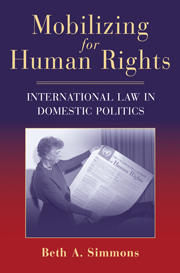Book contents
- Frontmatter
- Contents
- List of Figures and Tables
- Acknowledgments
- Abbreviations
- Part I
- Part II
- 5 Civil Rights
- 6 Equality for Women: Education, Work, and Reproductive Rights
- 7 Humane Treatment: The Prevalence and Prevention of Torture
- 8 The Protection of Innocents: Rights of the Child
- 9 Conclusion
- Appendix 1 Data Appendix
- Appendix 2 Regime Type and Rule of Law Categories
- References
- Index
6 - Equality for Women: Education, Work, and Reproductive Rights
Published online by Cambridge University Press: 05 June 2012
- Frontmatter
- Contents
- List of Figures and Tables
- Acknowledgments
- Abbreviations
- Part I
- Part II
- 5 Civil Rights
- 6 Equality for Women: Education, Work, and Reproductive Rights
- 7 Humane Treatment: The Prevalence and Prevention of Torture
- 8 The Protection of Innocents: Rights of the Child
- 9 Conclusion
- Appendix 1 Data Appendix
- Appendix 2 Regime Type and Rule of Law Categories
- References
- Index
Summary
Recognition of the inherent dignity and of the equal and inalienable rights of all members of the human family is the foundation of freedom, justice and peace in the world.
UN Universal Declaration of Human RightsCEDAW is an international agreement that will change the relationship between labor and employers and women and men in Japan. If we do not have the agreement, Japanese society will not move toward change.
Editorial, Yomiuri Shimbun, 27 July 1984The legal regime for international human rights has always been conceived as universal – that is, as applying to every human being. As time passed, however, it became clear to specific groups of activists how it would help their cause were these rights to be institutionalized for specific vulnerable groups. Racial minorities, women, and children were to be protected by waves of obligations that not only formalized earlier treaties, such as the ICCPR and ICESCR, but also addressed concerns specific to these groups. This chapter asks whether and how the CEDAW has improved the rights chances of women around the world.
In the previous chapter, the ICCPR was shown to be associated with improvements in the delivery of civil and political rights, though these findings were hardly uniform. The strongest effects were found not in the stable autocracies or the stable democracies, but rather in those countries in which only moderate levels of democracy exist or that experienced a transition (whether liberal or illiberal).
- Type
- Chapter
- Information
- Mobilizing for Human RightsInternational Law in Domestic Politics, pp. 202 - 255Publisher: Cambridge University PressPrint publication year: 2009



